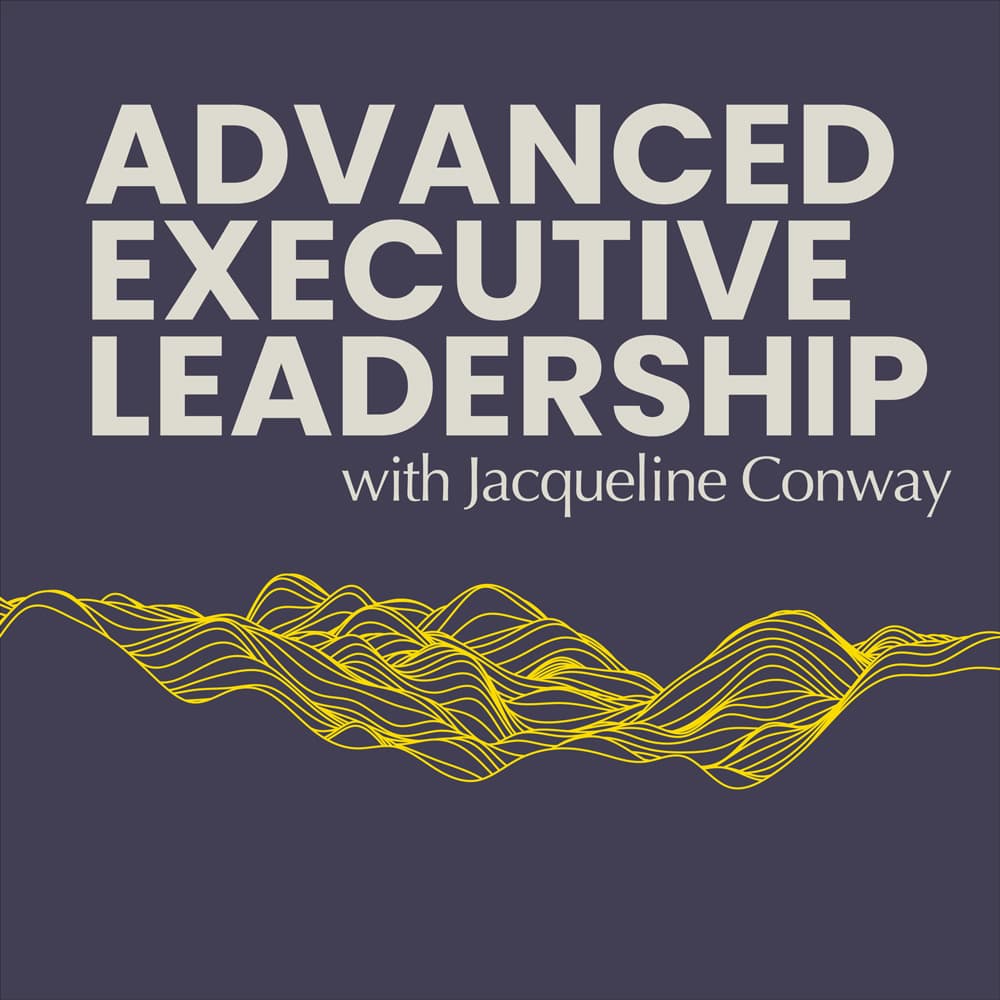In today’s podcast episode, I’d like to talk about a source of insight and data that leaders have in their toolkit to inform their decision making that’s oftentimes neglected.
I’ll explore what this is, why it is and what you as a leader can do about it.
Over the course of the episodes of this podcast we’ve heard from numerous CEO and CPO guests that the issues executive level leaders are confronted with don’t have off-the-shelf answers. They’re the sort of gnarly problems that require executive teams to sit with the problem to understand the issue and find appropriate ways to deal with it.
But because these issues are so hard to deal with, they’re inherently anxiety provoking. And it’s in this situation that I’ve seen executive teams seduced into finding any answer… (it has an energy of ‘let’s do something: anything) and it’s primarily to provide themselves with a sense of relief that they’re doing something.
In these situations, decision making can become as much an anxiety management strategy as it is a legitimate way to solve an organisational problem.
This is in stark contrast to the assumption – or at least desire – that executive level decision-making is a rational process.
The truth is that how a decision was taken is often post-rationalised as rational, even when there was a deeply emotional component to it. And leaders do this because the emotional – or what we might call the affective – part of problem solving isn’t seen as legitimate in Western corporations. Decisions based on cool reason is the gold standard – supposedly.
Barrier 1 – “Rational” decision making
Long after the idea of ‘rational economic man’ was abandoned in economics, it still forms of the basis of how we believe people in organisations ought to behave.
Our obsession with rationality in leadership assumes that cool reason (on one side) and emotion (on the other) are distinct internal processes that preside in different parts of our mind. If they’re independent of each other, the logic goes, then leaders should access the rational side to make the best, most reasoned decisions.
The admonishment to ‘keep it rational’ assumes both the leaders can bracket off their emotions and that doing so is desirable.
During the early days of Covid, leaders felt as overwhelmed and frightened as everyone else. Even as they watched the businesses, they led nearly obliterated, the expectation on leaders was to be strong and provide reassurance to others. The pressure and responsibility on leaders are burdensome, and it’s not uncommon for coaches to hear executive leaders ask why anyone would want to do this work. The denial of a leaders as human beings first and foremost results is much suffering and derailment.
Both assumptions have been firmly debunked by many scholars, most notably by the acclaimed neuroscientist, Antonio Damasio.[1] His work discovered that patients with forms of brain injury resulting in reduced emotional processing were less able to reason well. Emotions, and their human biological underpinnings, he proved, are intimately involved in all aspects of decision-making. In so doing, Damasio upended the traditional view that sound decisions come from a cool head. Yet a ‘cool head’ is still the seen as the gold standard in corporate decision making.
‘Be rational’ is synonymous with ‘be strong’; an overly masculinised view of leadership that’s had its day. A leader once told me “If you show weakness here, they’ll scythe you off at the knees”. How can anyone be expected to bring their best selves within such a culture?
In our modern knowledge economies, we need people to bring their whole selves to work. It means accepting, especially in HR and People functions that instead of policies of mechanisms of control, we must embrace the messiness of human beings in our workplace. There is no alternative because it just is. The more we try to take out the messiness, we more we remove the brilliance.
For leaders to lead in this way, they must also be this way and accept that leadership is relational. And if it’s relational, then the role of empathy and taking seriously the feelings of others is a vital part of leadership.
When viewed this way, emotion has more of a fighting chance of being given its rightful place.
The right kind of data
Data now sits at the heart of planning, problem solving and decision making in organisations. Whether it’s hard facts, statistics, or spreadsheets; data is raised on a pedestal of rationality. We have come to accept that a rational data-drive decision making style; characterised by research for, and logical evaluation of, data is the only decision-making style.
It has long been an unquestioned assumption in organisations that any quantitative data in supporting leadership decision making is better than no data. The ability to use data to make decisions is based on being able to present it in a logical, rational way and fit the Western business norm that numbers are king. Even when the use of quantitative data isn’t suitable for the subject matter at hand – think culture surveys or ‘measuring’ staff engagement – these data are still highly prized.
A hunch or gut feeling holds a lot less weight than numbers. But it shouldn’t be discounted so readily. Gary Klein researched how experienced firefighters just knew when to get out a burning building the moment before it collapsed. This led to decades of research on what creates insight. He found that leaders “weren’t trying to compare options to select the best” rather, they “relied on their experience, the patterns they had acquired over decades, to quickly size up situations and recognise the option most likely to work.
This speaks to the inherent wisdom and deep knowledge that an experienced leader has gained over a lifetime. Discounting this is what leads to an over reliance on quantitative data even though it’s widely accepted that much decision making is made emotionally and post-rationalised with hard facts.
What is Emotional Fluency
Emotions play a significant part in decision making. Even in decision making that leans heavily on data. Because it isn’t the data that makes the decision – people do. Therefore, no amount of data is a substitute for good judgment.
In the research that I’ve just published this is what I mean by cultivating Emotional Fluency – that leaders tune into their emotions and know what they are feeling – without judgement.
And not just at an individual level. The group dynamic in the executive team impacts and is impacted by individual emotions. Rather than try to cover decision making in a cloak of rationality, Emotional Fluency requires that leaders accept that even sound and rational decisions are made using a combination of objective and subjective factors.
If we accept that subjectivity comes into leaders’ decision making, then the focus shifts from trying to remove subjectivity to exploring the impact it has on decision making and whether it is working in our favour.
We all have a dark side, and we’re sometimes driven by it. Becoming emotionally fluent isn’t just about recognising, accepting, and working with those tolerable parts of ourselves but also those darker parts that we’d rather we didn’t have. When we bring it into the open and integrate it in our decision making, we neutralise the ways that it can be harmful in an organisational setting.
The interconnected aspect of the leaders’ outer world in the organisation and in the executive suite is interwoven with their inner world.
Empathy and attunement
When we lead, it’s in the service of others; to meet a need they have. To lead well, it follows, a leader must be able to identify with the inner life of another person or group. This is the essence of empathy.
As the report has outlined, looking after the interests of one group at the expense of another is problematic in today’s milieu. Leadership empathy is now to be directed towards a diverse stakeholder population, requiring leaders to develop their natural ability to empathise within multiple others.
But empathy alone is not enough because it’s limited to the intellectual identification of another’s position. What’s needed is the deeper quality of resonating at the level of feeling. This is attunement.
We can’t have attunement without empathy, and both are required for thoughtful leaders in today’s diverse stakeholder environment. To develop them, leaders must cultivate their feeling capacities as much as their thinking abilities.
The subjective life of the group
In an executive team, the team is as important as the executive. The leader and the team are formed in a continual state of interaction with each other. When it’s high functioning, the team becomes a positive developmental space for individual leaders to grow, and the functioning of the entire group expands.
In much the same way that the individual leaders must become attuned to their individual emotional states, the team must also become aware of what’s known as it’s ‘affective tone’. Feelings such as optimism about the future, or a collective feeling of incompetence, have a significant impact on
the team’s ability to exercise good judgement. Therefore, the affective tone is one of the factors that defines the team’s culture and distinguishes it from a mere collection of individuals.
Usually, the CEO has a disproportionate impact on the emotional state due to the mirroring that happens between people’s feelings and the emotional contagion that happens in teams. These issues are more likely to be openly talked about and worked through in a team characterised
by psychological safety. To create such an environment, the feelings of team members must be given their rightful place as an important dynamic within the team.
The dark side
Every person carries the wounds from a personal history that was imperfect. The challenges people have endured can be the driving force of them wanting to become a leader. But they manifest in both a bright side and a dark side.
The bright side is the part of ourselves we want
the world to see. In contrast, the dark side: envy, greed, selfishness etc, carries shame and guilt. It’s the part that we try to keep hidden in the shadows. Both influence leadership behaviour, but some are better able to manage it than others.
The dark side, left unchecked, can wreak havoc. It matters so much in the C-suite, with the accompanying power and access to resources, because the impact of a leader playing out their dark side here can do so much more harm.
The goal is not to overcome the dark side; this isn’t possible since it’s part of the human condition. Rather the work of developing Emotional Fluency is to bring our dark side out of the shadows and work productively with it, being open about the impact that is has on who you are as a leader.
[1] Damasio, A. (2006) Descartes’ Error. Random House: London.


